brake NISSAN PATHFINDER HYBRID 2015 Owners Manual
[x] Cancel search | Manufacturer: NISSAN, Model Year: 2015, Model line: PATHFINDER HYBRID, Model: NISSAN PATHFINDER HYBRID 2015Pages: 524, PDF Size: 6.49 MB
Page 10 of 524
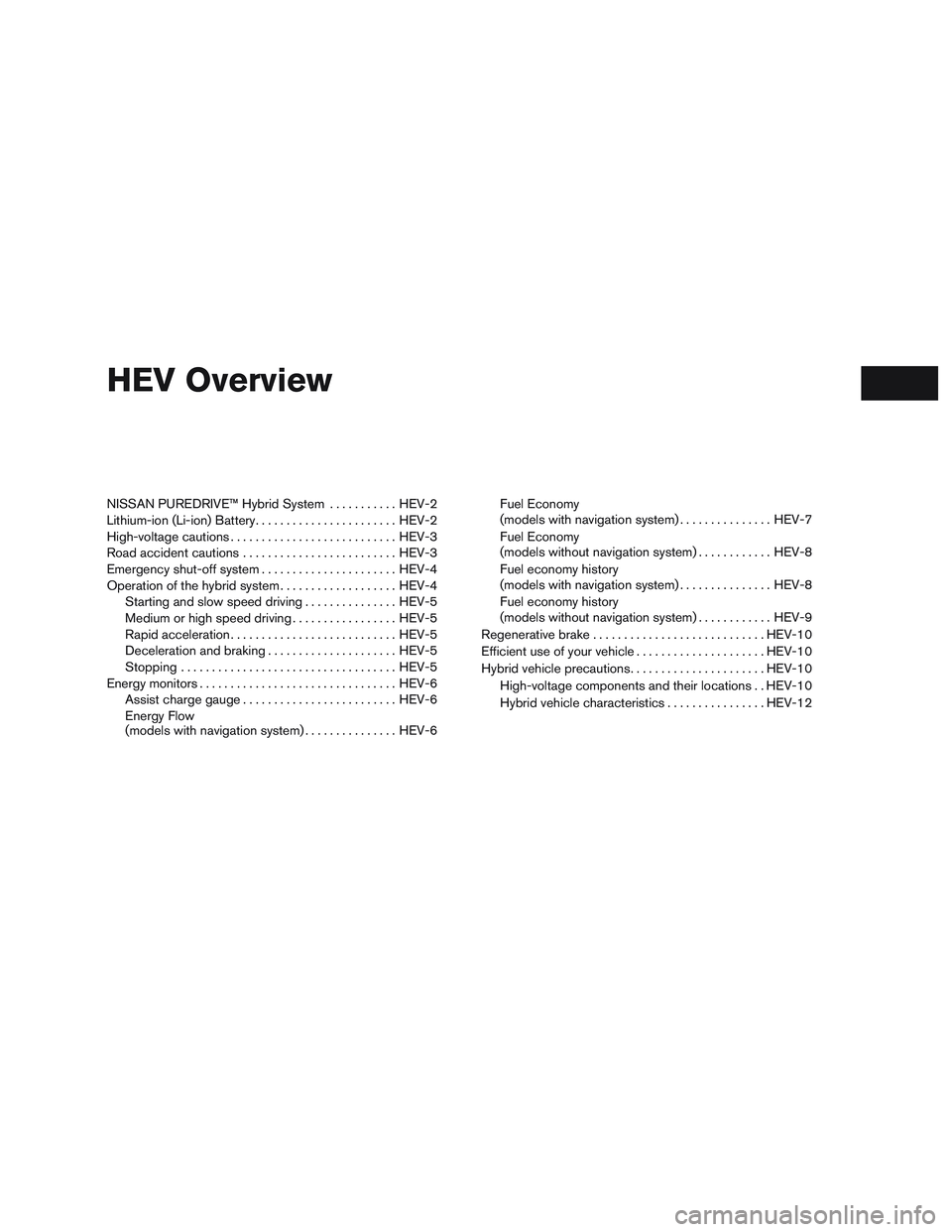
HEV Overview
NISSAN PUREDRIVE™ Hybrid System...........HEV-2
Lithium-ion (Li-ion) Battery.......................HEV-2
High-voltage cautions...........................HEV-3
Road accident cautions.........................HEV-3
Emergency shut-off system......................HEV-4
Operation of the hybrid system...................HEV-4
Starting and slow speed driving...............HEV-5
Medium or high speed driving . ................HEV-5
Rapid acceleration...........................HEV-5
Deceleration and braking.....................HEV-5
Stopping...................................HEV-5
Energy monitors................................HEV-6
Assist charge gauge.........................HEV-6
Energy Flow
(models with navigation system)...............HEV-6Fuel Economy
(models with navigation system)...............HEV-7
Fuel Economy
(models without navigation system)............HEV-8
Fuel economy history
(models with navigation system)...............HEV-8
Fuel economy history
(models without navigation system)............HEV-9
Regenerative brake............................HEV-10
Efficient use of your vehicle.....................HEV-10
Hybrid vehicle precautions......................HEV-10
High-voltage components and their locations . . HEV-10
Hybrid vehicle characteristics................HEV-12
Page 12 of 524
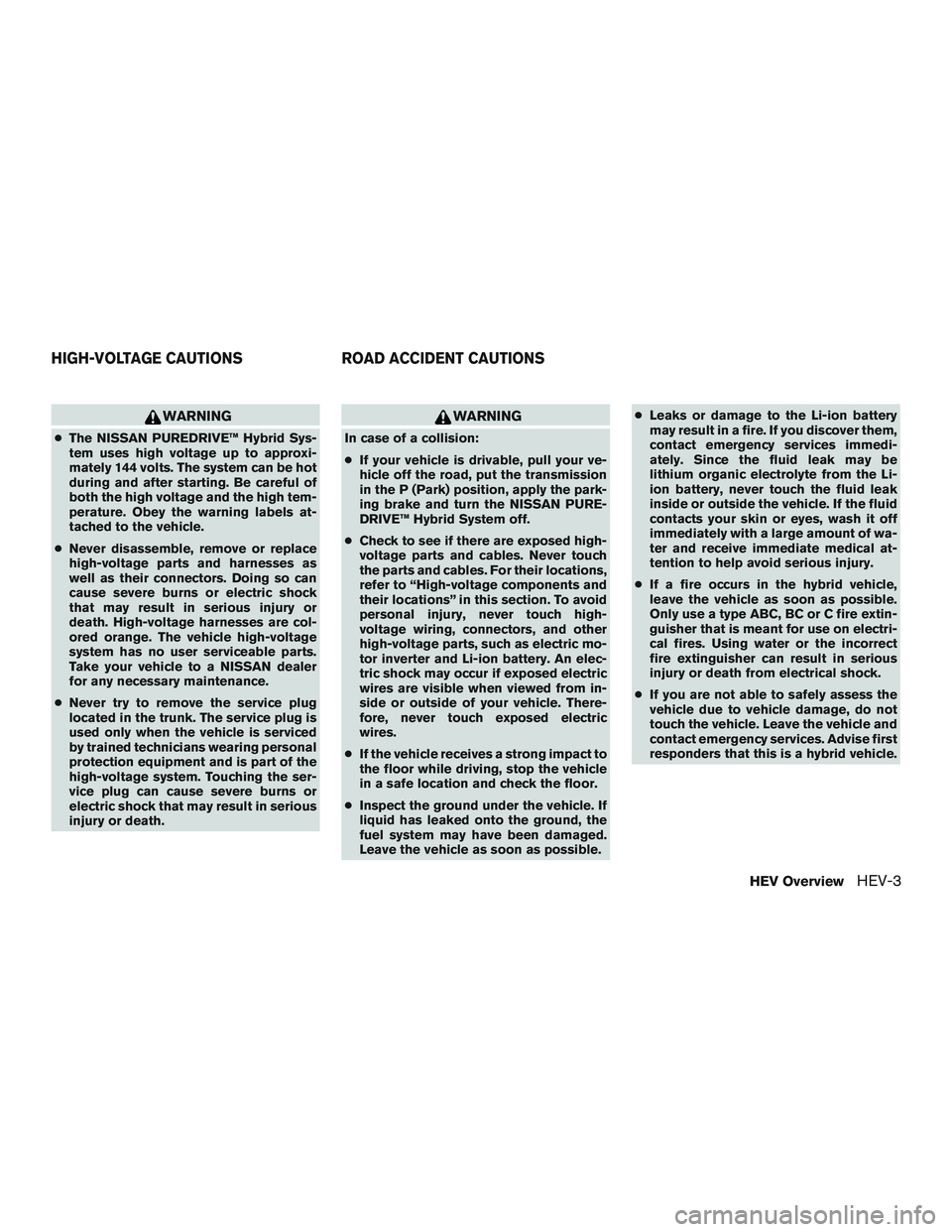
WARNING
●The NISSAN PUREDRIVE™ Hybrid Sys-
tem uses high voltage up to approxi-
mately 144 volts. The system can be hot
during and after starting. Be careful of
both the high voltage and the high tem-
perature. Obey the warning labels at-
tached to the vehicle.
●Never disassemble, remove or replace
high-voltage parts and harnesses as
well as their connectors. Doing so can
cause severe burns or electric shock
that may result in serious injury or
death. High-voltage harnesses are col-
ored orange. The vehicle high-voltage
system has no user serviceable parts.
Take your vehicle to a NISSAN dealer
for any necessary maintenance.
●Never try to remove the service plug
located in the trunk. The service plug is
used only when the vehicle is serviced
by trained technicians wearing personal
protection equipment and is part of the
high-voltage system. Touching the ser-
vice plug can cause severe burns or
electric shock that may result in serious
injury or death.
WARNING
In case of a collision:
●If your vehicle is drivable, pull your ve-
hicle off the road, put the transmission
in the P (Park) position, apply the park-
ing brake and turn the NISSAN PURE-
DRIVE™ Hybrid System off.
●Check to see if there are exposed high-
voltage parts and cables. Never touch
the parts and cables. For their locations,
refer to “High-voltage components and
their locations” in this section. To avoid
personal injury, never touch high-
voltage wiring, connectors, and other
high-voltage parts, such as electric mo-
tor inverter and Li-ion battery. An elec-
tric shock may occur if exposed electric
wires are visible when viewed from in-
side or outside of your vehicle. There-
fore, never touch exposed electric
wires.
●If the vehicle receives a strong impact to
the floor while driving, stop the vehicle
in a safe location and check the floor.
●Inspect the ground under the vehicle. If
liquid has leaked onto the ground, the
fuel system may have been damaged.
Leave the vehicle as soon as possible.●Leaks or damage to the Li-ion battery
may result in a fire. If you discover them,
contact emergency services immedi-
ately. Since the fluid leak may be
lithium organic electrolyte from the Li-
ion battery, never touch the fluid leak
inside or outside the vehicle. If the fluid
contacts your skin or eyes, wash it off
immediately with a large amount of wa-
ter and receive immediate medical at-
tention to help avoid serious injury.
●If a fire occurs in the hybrid vehicle,
leave the vehicle as soon as possible.
Only use a type ABC, BC or C fire extin-
guisher that is meant for use on electri-
cal fires. Using water or the incorrect
fire extinguisher can result in serious
injury or death from electrical shock.
●If you are not able to safely assess the
vehicle due to vehicle damage, do not
touch the vehicle. Leave the vehicle and
contact emergency services. Advise first
responders that this is a hybrid vehicle.
HIGH-VOLTAGE CAUTIONS ROAD ACCIDENT CAUTIONS
HEV OverviewHEV-3
Page 13 of 524

●In the event of an accident that requires
body repair and painting, the vehicle
should be delivered to a NISSAN dealer
to have the Li-ion battery pack and
high-voltage parts such as the inverter,
including the wiring harness, removed
prior to painting. Li-ion battery packs
exposed to heat in the paint booth will
experience capacity loss. Damaged Li-
ion battery packs may also pose safety
risks to untrained mechanics and repair
personnel.The emergency shut-off system is activated and
the high-voltage system automatically turns off in
the following conditions:
●Front and side collisions in which the air
bags are deployed.
●Certain rear collisions.
●Certain NISSAN PUREDRIVE™ Hybrid Sys-
tem malfunctions
For the above collisions and the certain hybrid
system malfunctions, the READY to drive indica-
tor light will turn off. For additional information,
refer to “Warning/indicator lights and audible
reminders” in the “Instruments and controls” sec-
tion of this manual.
The emergency shut-off activates for the above
collisions to minimize risk of an event that could
cause injury or an accident. If the emergency
shut-off system activates, the hybrid system may
not switch to READY to drive position. Contact a
NISSAN dealer. Even if the ignition switch is
switched to READY to drive position, the system
may shut off suddenly. Therefore, drive cautiously
to the nearest NISSAN dealer or contact a
NISSAN dealer as soon as possible.To start the NISSAN PUREDRIVE™ Hybrid Sys-
tem, depress the brake pedal and place the igni-
tion switch in the ON position when the transmis-
sion is in the P (Park) position.
CAUTION
Do not start the system in N (Neutral)
position under cold condition of the sys-
tem. Start in the P (Park) position in that
case.
The READY to drive indicator light
flashes
until the hybrid system is ready to drive.
If starting in a low temperature environment, the
flashing time of the READY to drive indicator light
becomes longer. It cannot move out from P range
during flashing.
When the READY to drive indicator light
illuminates, the vehicle can be driven, even if the
gasoline engine is not running.
NOTE:
The gasoline engine starts and stops auto-
matically. It may stop during deceleration
or when the vehicle is stopped.
EMERGENCY SHUT-OFF SYSTEM OPERATION OF THE HYBRID
SYSTEM
HEV-4HEV Overview
Page 14 of 524
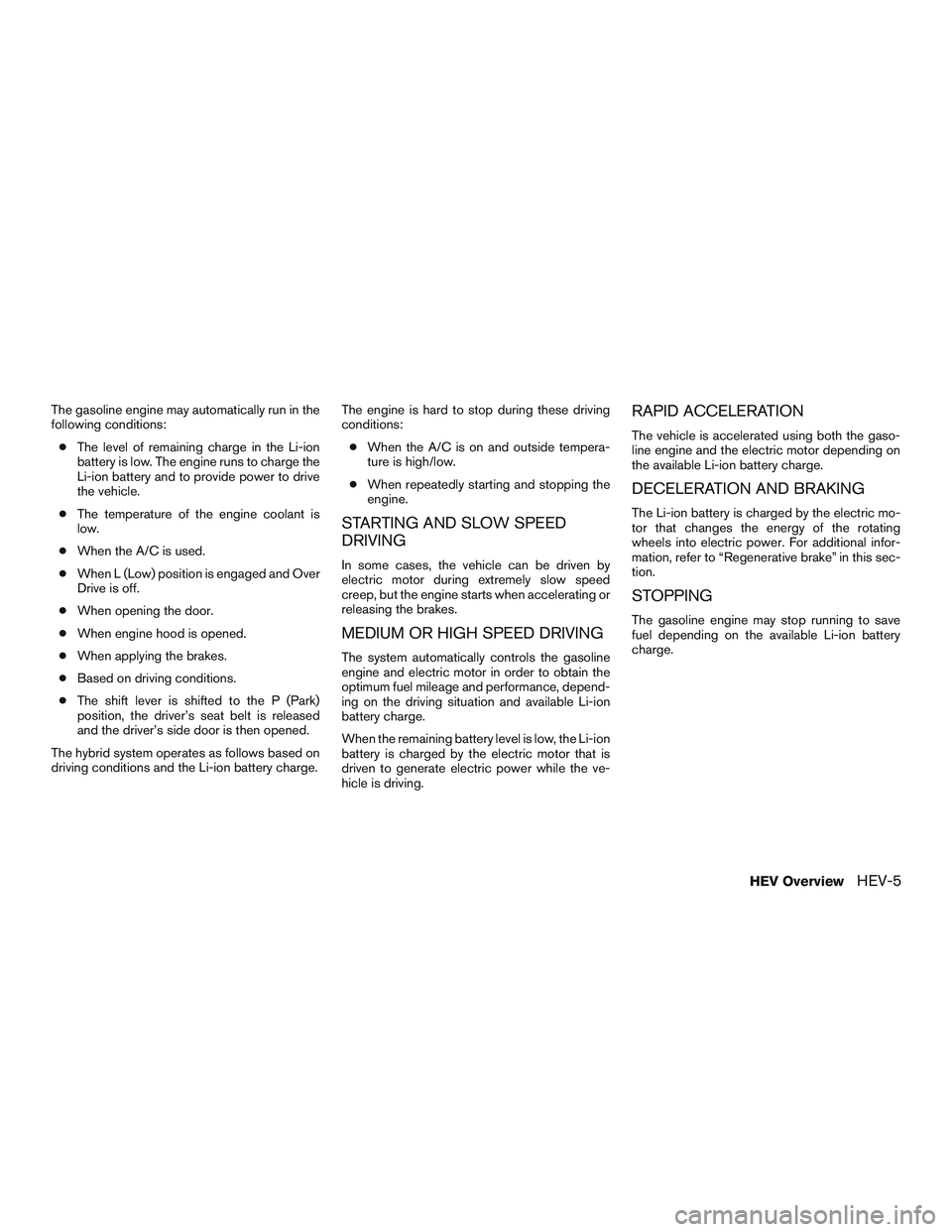
The gasoline engine may automatically run in the
following conditions:
●The level of remaining charge in the Li-ion
battery is low. The engine runs to charge the
Li-ion battery and to provide power to drive
the vehicle.
●The temperature of the engine coolant is
low.
●When the A/C is used.
●When L (Low) position is engaged and Over
Drive is off.
●When opening the door.
●When engine hood is opened.
●When applying the brakes.
●Based on driving conditions.
●The shift lever is shifted to the P (Park)
position, the driver’s seat belt is released
and the driver’s side door is then opened.
The hybrid system operates as follows based on
driving conditions and the Li-ion battery charge.The engine is hard to stop during these driving
conditions:
●When the A/C is on and outside tempera-
ture is high/low.
●When repeatedly starting and stopping the
engine.
STARTING AND SLOW SPEED
DRIVING
In some cases, the vehicle can be driven by
electric motor during extremely slow speed
creep, but the engine starts when accelerating or
releasing the brakes.
MEDIUM OR HIGH SPEED DRIVING
The system automatically controls the gasoline
engine and electric motor in order to obtain the
optimum fuel mileage and performance, depend-
ing on the driving situation and available Li-ion
battery charge.
When the remaining battery level is low, the Li-ion
battery is charged by the electric motor that is
driven to generate electric power while the ve-
hicle is driving.
RAPID ACCELERATION
The vehicle is accelerated using both the gaso-
line engine and the electric motor depending on
the available Li-ion battery charge.
DECELERATION AND BRAKING
The Li-ion battery is charged by the electric mo-
tor that changes the energy of the rotating
wheels into electric power. For additional infor-
mation, refer to “Regenerative brake” in this sec-
tion.
STOPPING
The gasoline engine may stop running to save
fuel depending on the available Li-ion battery
charge.
HEV OverviewHEV-5
Page 16 of 524
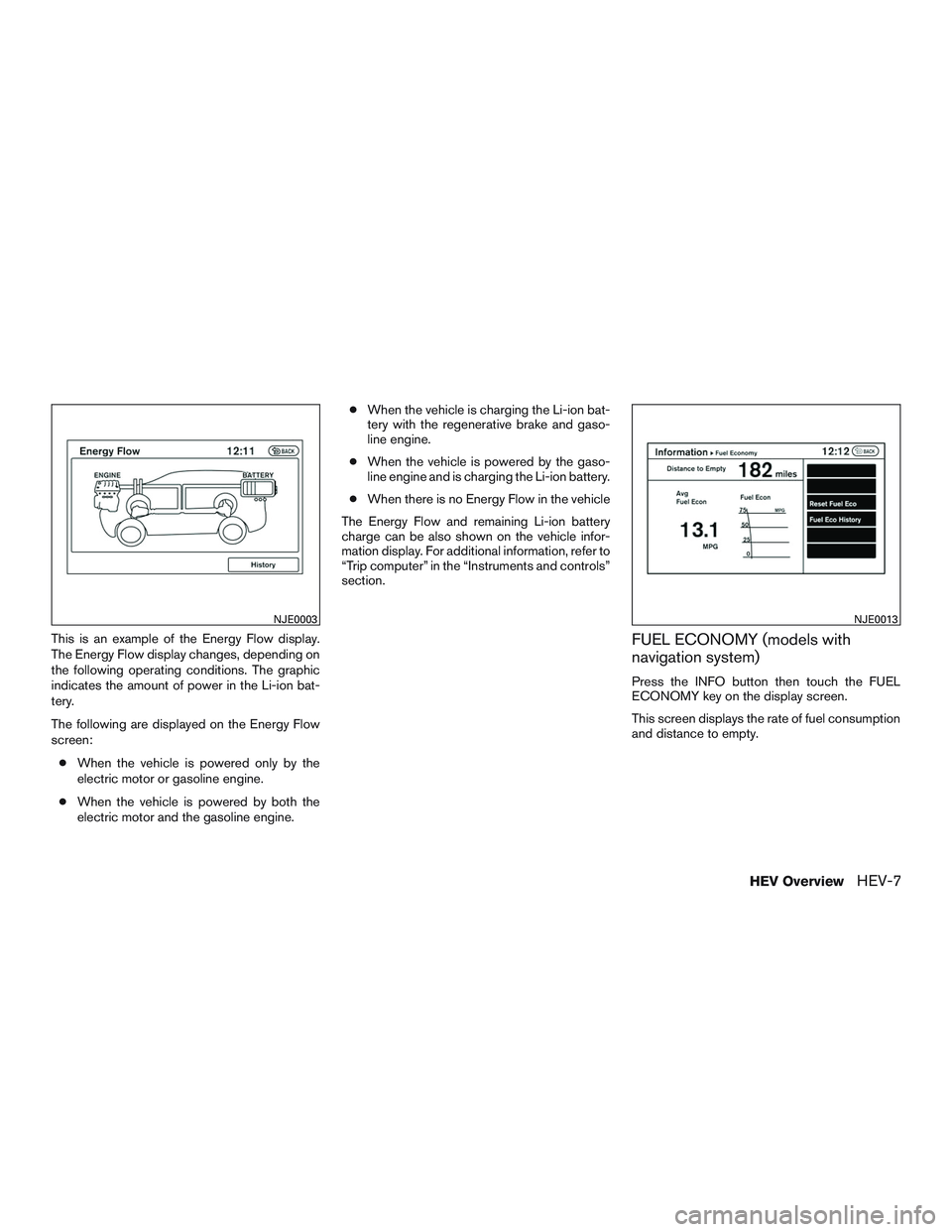
This is an example of the Energy Flow display.
The Energy Flow display changes, depending on
the following operating conditions. The graphic
indicates the amount of power in the Li-ion bat-
tery.
The following are displayed on the Energy Flow
screen:
●When the vehicle is powered only by the
electric motor or gasoline engine.
●When the vehicle is powered by both the
electric motor and the gasoline engine.●When the vehicle is charging the Li-ion bat-
tery with the regenerative brake and gaso-
line engine.
●When the vehicle is powered by the gaso-
line engine and is charging the Li-ion battery.
●When there is no Energy Flow in the vehicle
The Energy Flow and remaining Li-ion battery
charge can be also shown on the vehicle infor-
mation display. For additional information, refer to
“Trip computer” in the “Instruments and controls”
section.FUEL ECONOMY (models with
navigation system)
Press the INFO button then touch the FUEL
ECONOMY key on the display screen.
This screen displays the rate of fuel consumption
and distance to empty.
NJE0003NJE0013
HEV OverviewHEV-7
Page 19 of 524
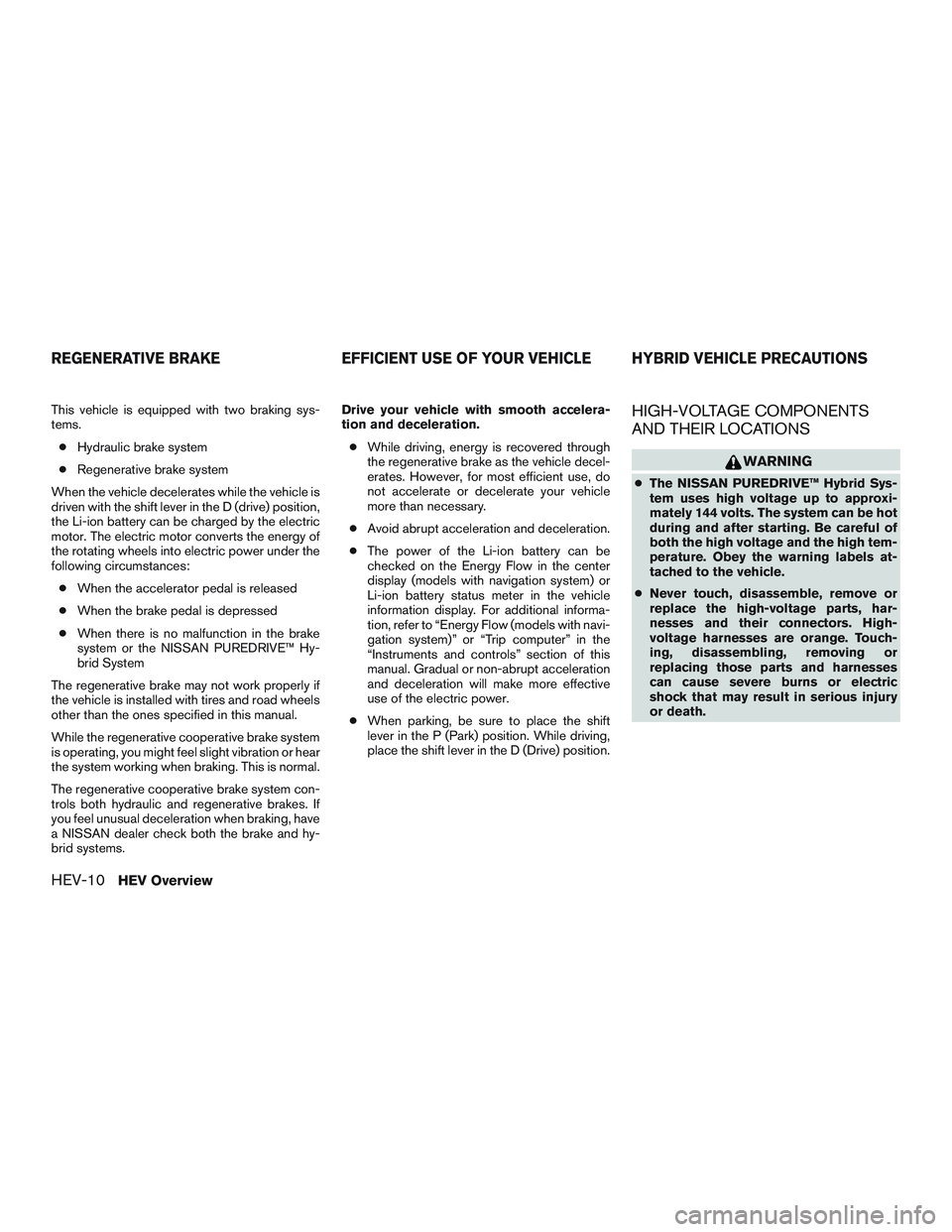
This vehicle is equipped with two braking sys-
tems.
●Hydraulic brake system
●Regenerative brake system
When the vehicle decelerates while the vehicle is
driven with the shift lever in the D (drive) position,
the Li-ion battery can be charged by the electric
motor. The electric motor converts the energy of
the rotating wheels into electric power under the
following circumstances:
●When the accelerator pedal is released
●When the brake pedal is depressed
●When there is no malfunction in the brake
system or the NISSAN PUREDRIVE™ Hy-
brid System
The regenerative brake may not work properly if
the vehicle is installed with tires and road wheels
other than the ones specified in this manual.
While the regenerative cooperative brake system
is operating, you might feel slight vibration or hear
the system working when braking. This is normal.
The regenerative cooperative brake system con-
trols both hydraulic and regenerative brakes. If
you feel unusual deceleration when braking, have
a NISSAN dealer check both the brake and hy-
brid systems.Drive your vehicle with smooth accelera-
tion and deceleration.
●While driving, energy is recovered through
the regenerative brake as the vehicle decel-
erates. However, for most efficient use, do
not accelerate or decelerate your vehicle
more than necessary.
●Avoid abrupt acceleration and deceleration.
●The power of the Li-ion battery can be
checked on the Energy Flow in the center
display (models with navigation system) or
Li-ion battery status meter in the vehicle
information display. For additional informa-
tion, refer to “Energy Flow (models with navi-
gation system)” or “Trip computer” in the
“Instruments and controls” section of this
manual. Gradual or non-abrupt acceleration
and deceleration will make more effective
use of the electric power.
●When parking, be sure to place the shift
lever in the P (Park) position. While driving,
place the shift lever in the D (Drive) position.HIGH-VOLTAGE COMPONENTS
AND THEIR LOCATIONS
WARNING
●The NISSAN PUREDRIVE™ Hybrid Sys-
tem uses high voltage up to approxi-
mately 144 volts. The system can be hot
during and after starting. Be careful of
both the high voltage and the high tem-
perature. Obey the warning labels at-
tached to the vehicle.
●Never touch, disassemble, remove or
replace the high-voltage parts, har-
nesses and their connectors. High-
voltage harnesses are orange. Touch-
ing, disassembling, removing or
replacing those parts and harnesses
can cause severe burns or electric
shock that may result in serious injury
or death.
REGENERATIVE BRAKE EFFICIENT USE OF YOUR VEHICLE HYBRID VEHICLE PRECAUTIONS
HEV-10HEV Overview
Page 22 of 524
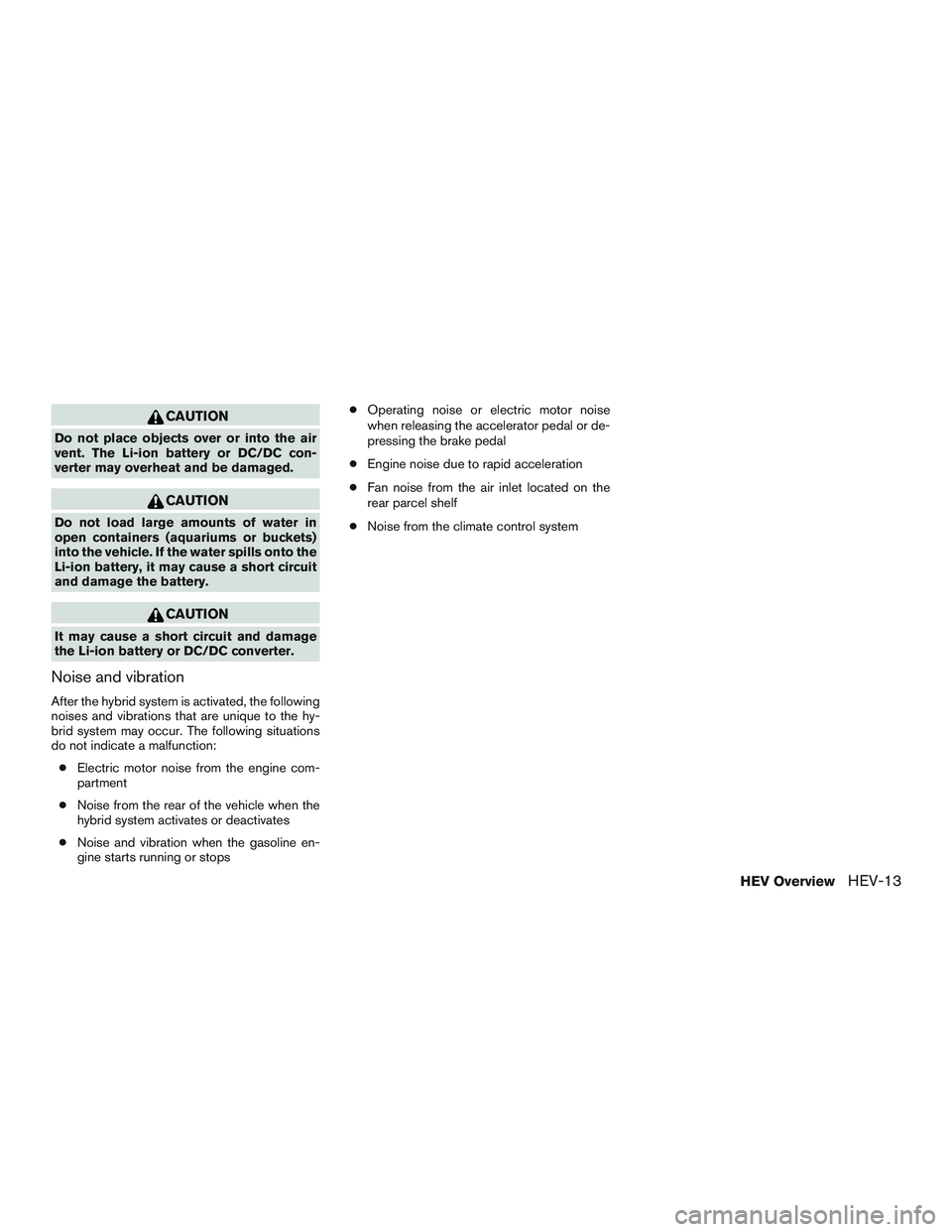
CAUTION
Do not place objects over or into the air
vent. The Li-ion battery or DC/DC con-
verter may overheat and be damaged.
CAUTION
Do not load large amounts of water in
open containers (aquariums or buckets)
into the vehicle. If the water spills onto the
Li-ion battery, it may cause a short circuit
and damage the battery.
CAUTION
It may cause a short circuit and damage
the Li-ion battery or DC/DC converter.
Noise and vibration
After the hybrid system is activated, the following
noises and vibrations that are unique to the hy-
brid system may occur. The following situations
do not indicate a malfunction:
●Electric motor noise from the engine com-
partment
●Noise from the rear of the vehicle when the
hybrid system activates or deactivates
●Noise and vibration when the gasoline en-
gine starts running or stops●Operating noise or electric motor noise
when releasing the accelerator pedal or de-
pressing the brake pedal
●Engine noise due to rapid acceleration
●Fan noise from the air inlet located on the
rear parcel shelf
●Noise from the climate control system
HEV OverviewHEV-13
Page 31 of 524
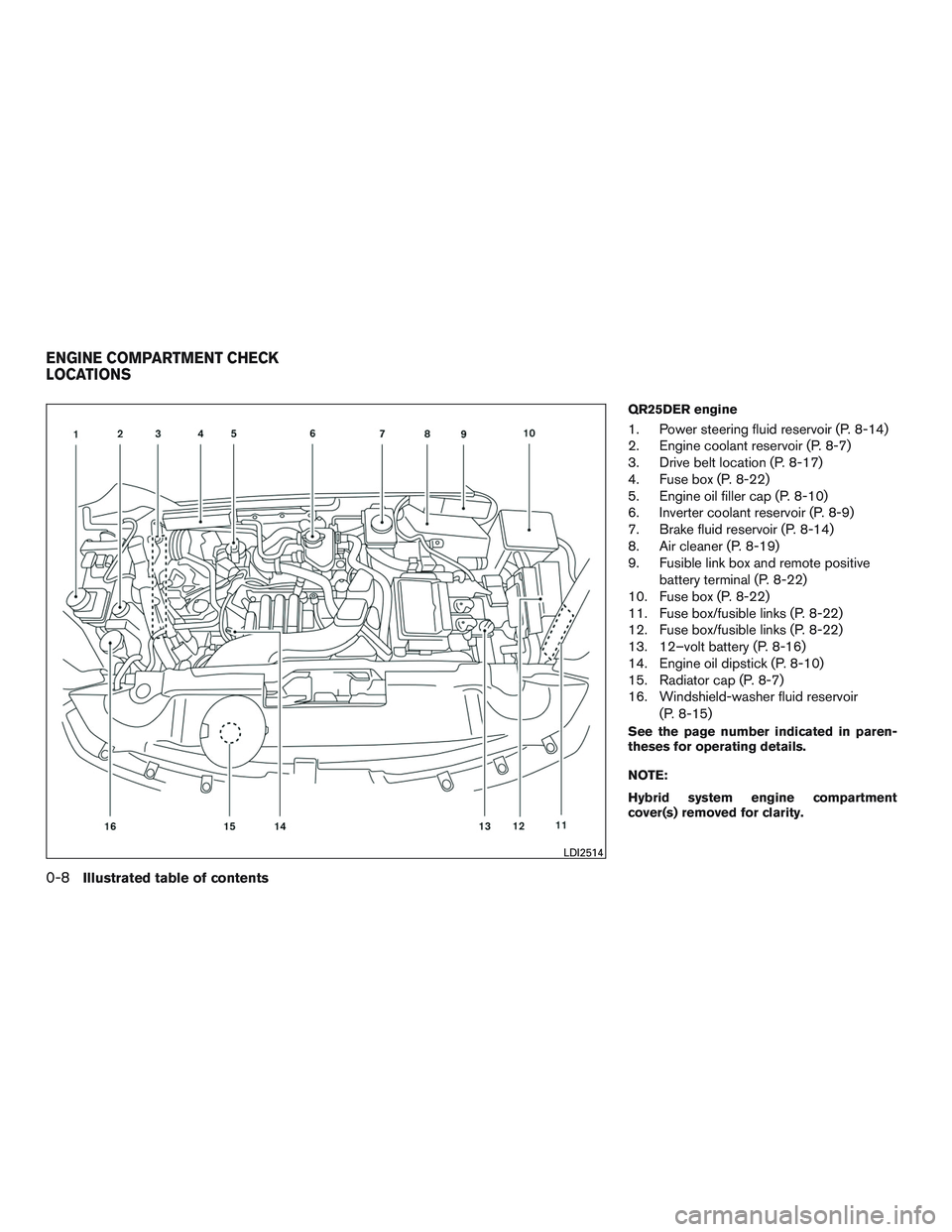
QR25DER engine
1. Power steering fluid reservoir (P. 8-14)
2. Engine coolant reservoir (P. 8-7)
3. Drive belt location (P. 8-17)
4. Fuse box (P. 8-22)
5. Engine oil filler cap (P. 8-10)
6. Inverter coolant reservoir (P. 8-9)
7. Brake fluid reservoir (P. 8-14)
8. Air cleaner (P. 8-19)
9. Fusible link box and remote positive
battery terminal (P. 8-22)
10. Fuse box (P. 8-22)
11. Fuse box/fusible links (P. 8-22)
12. Fuse box/fusible links (P. 8-22)
13. 12–volt battery (P. 8-16)
14. Engine oil dipstick (P. 8-10)
15. Radiator cap (P. 8-7)
16. Windshield-washer fluid reservoir
(P. 8-15)
See the page number indicated in paren-
theses for operating details.
NOTE:
Hybrid system engine compartment
cover(s) removed for clarity.
LDI2514
ENGINE COMPARTMENT CHECK
LOCATIONS
0-8Illustrated table of contents
Page 32 of 524

Warning
lightName Page
Anti-lock Braking
System (ABS) warn-
ing light2-10
or
Brake warning light 2-10
12–volt battery
charge warning light2-11
Electronically con-
trolled brake warn-
ing light (yellow)2-11
Engine oil pressure
warning light2-12
High temperature
warning light2-12
Pure Drive Hybrid™
system warning light2-12
Warning
lightName Page
Low tire pressure
warning light2-12
Low windshield-
washer fluid warning
light2-14
Master warning light 2-14
Power steering
warning light2-14
Seat belt warning
light and chime2-14
Supplemental air
bag warning light2-15
Indicator
lightName Page
EV indicator light 2-15
Front fog light indi-
cator light2-15
Front passenger air
bag status light2-15
High beam indicator
light (blue)2-15
Hill descent control
system on indicator
light (if so equipped)2-15
Low temperature
indicator light2-16
Malfunction Indica-
tor Light (MIL)2-16
Overdrive off indica-
tor light2-17
WARNING/INDICATOR LIGHTS
Illustrated table of contents0-9
Page 112 of 524

Anti-lock Braking System (ABS) warning
lightPower steering warning lightOverdrive off indicator light
orBrake warning lightSeat belt warning light and chimeREADY to drive indicator light
12–volt battery charge warning lightSupplemental air bag warning lightSecurity indicator light
Electronically controlled brake warning
light (yellow)EV indicator lightSide light and headlight indicator light (green)
Engine oil pressure warning lightFront fog light indicator lightSlip indicator light
High temperature warning lightFront passenger air bag status lightTow mode ON indicator light
Pure Drive Hybrid™ system warning lightHigh beam indicator light (blue)Turn signal/hazard indicator lights
Low tire pressure warning lightHill descent control system on
indicator light (if so equipped)Vehicle Dynamic Control (VDC) off indicator light
Low windshield-washer fluid warning
lightLow temperature indicator light
Master warning lightMalfunction Indicator Light (MIL)
WARNING/INDICATOR LIGHTS AND
AUDIBLE REMINDERS
Instruments and controls2-9